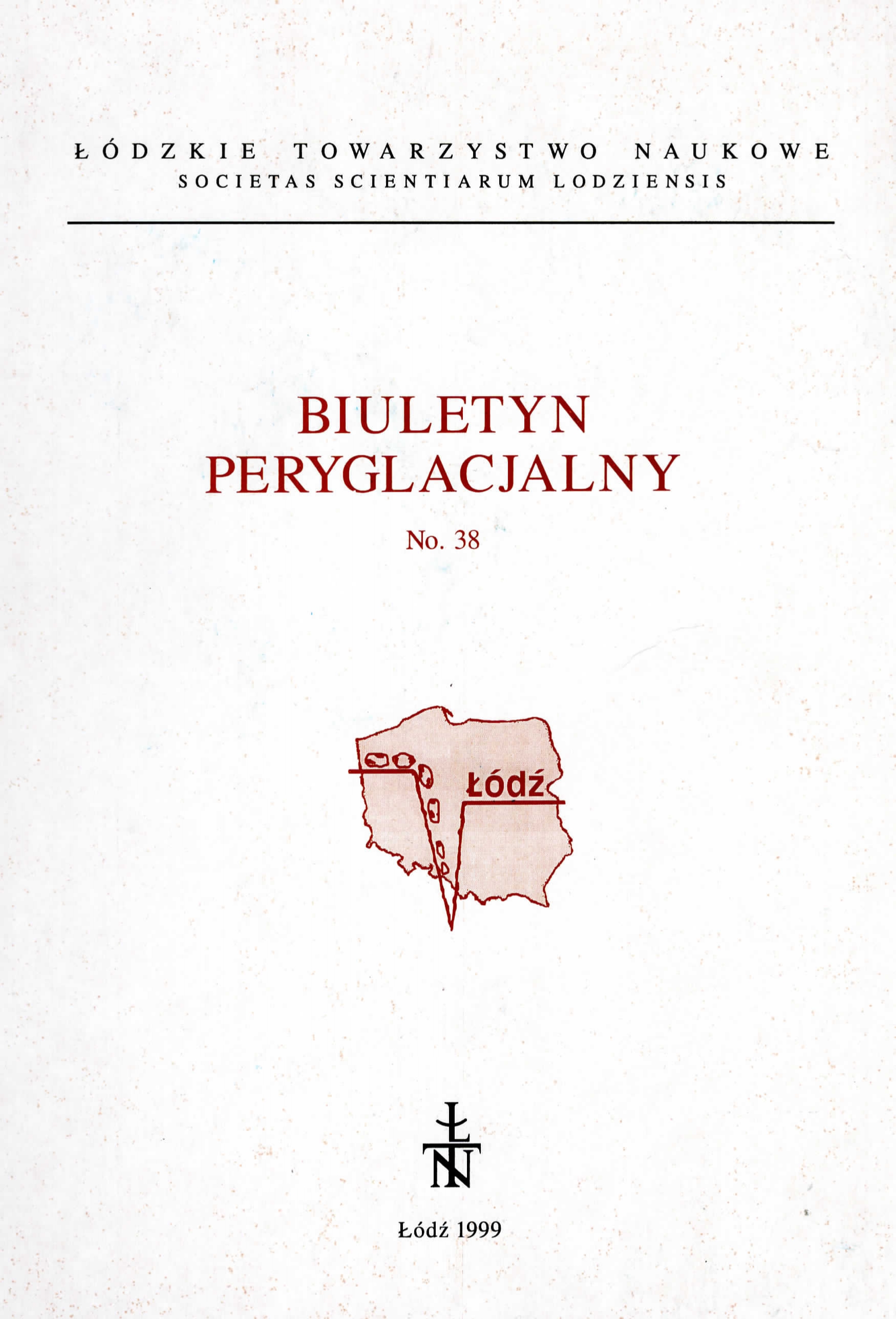Badania pseudomorfoz po klinach lodowych na Wyspach Brytyjskich w latach 1849-1949
DOI:
https://doi.org/10.26485/BP/1999/38/14Słowa kluczowe:
relikty wieloletniej zmarzliny, historia badań, postępy w interpretacjiAbstrakt
Chociaż 1949 był początkiem międzynarodowej współpracy w zakresie badań peryglacjalnych, w poprzednim stuleciu na Wyspach Brytyjskich poczyniono ważne obserwacje struktur związanych z wieczną zmarzliną. Prawdopodobnie najstarsza opublikowana rycina przedstawiająca pseudomorfozę po klinie lodowym pochodzi z 1848 roku. Później, w 1877 roku, opublikowano litografię pseudomorfozy po klinie lodowym z rejonu Fenland we wschodniej Anglii, a z Irlandii Północnej pochodzi pierwszy opis genetycznie powiązanych z zamarzaniem struktur szczelinowych powstałych w żwirach. Następnie zaproponowano podziemny mechanizm erozji, aby wyjaśnić duże struktury w kształcie klina w Cambridge. Badaniem referencyjnym było badanie T. T. Patersona, który w 1940 roku przeprowadził studia porównawcze klinów lodowych na Ziemi Baffina i analogicznych struktur klinowych w Cambridge. Jednocześnie tocząca się debata na temat sedymentologii glacjalnej pobudziła dyskusję na temat pierwszych znanych szkockich pseudomorfoz klinów lodowych. W końcu na zdjęciach lotniczych zidentyfikowano relikty wieloboków klinów lodowych.
Bibliografia
Anderson, J. G. C., 1940 - Glacial drifts near Roslin, Midlothian. Geological Magazine, 77; p. 470-473.
Anderson, J. G. C., 1942 - Glacial drifts. Geological Magazine, 78; p. 470-471.
Arkell, W. J., 1947 - The geology of Oxford. Oxford, Clarendon Press, 267 pp.
Carruthers, R. G., 1941 - Glacial drifts. Geological Magazine, 78; p. 316-317.
Carruthers, R. G., 1942 - Glacial drifts. Geological Magazine, 78; p. 153-154.
Castleden, R., 1980 - The second and third terraces of the River Nene. Mercian Geologist, 8; p. 29-46.
Church, R. E., Péwé, T. L., and Andersen, M., 1965 - Large scale patterned ground, Donnelly Dome area, Alaska. US Army Cold Regions Research and Engineering Laboratory, Research Report 159; 63 pp.
Colhoun, E. A., 1970 - Early record and interpretation of ice-wedge pseudomorph in County Londonderry, northern Ireland, by J. R. Kilroe. Journal of Glaciology 9; p. 391-392.
Fitzpatrick, E. A., 1956 - Progress report on the observations of periglacial phenomena in the British Isles. Biuletyn Peryglacjalny, 4; p. 99-115.
Kilroe, J. R., 1908 - Chapter 5. The Eastern District. In: Wilkinson, S. B., Mchenry, A., Kilroe, J. R., and Seymour, H. J, Geology of the country around Londonderry; p. 41-69, Memoirs of the Geological Survey of Ireland, Dublin, HMSO.
Leffingwell, E De K., 1915 - Ground-ice wedges; the dominant form of ground-ice on the north coast of Alaska. Journal of Geology, 23; p. 635-654.
Leffingwell, E De K., 1919 - The Canning River region, northern Alaska. Professional Papers of the United States Geological Survey, 109; 251 pp.
Marr, J. E., 1919 - The Pleistocene deposits around Cambridge. Quarterly Journal of the Geological Society of London, 75; p. 204-244.
Paterson, T. T., 1940 - The effects of frost action and solifluxion around Baffin Bay and in the Cambridge district. Quarterly Journal of the Geological Society of London, 96; p. 99-130.
Riley, D. N., 1944 - Archaeology from the air in the Upper Thames Valley. Oxoniensia, 8 & 9; p. 64-101.
Skertchley, S. B. J., 1877 - Geology of Fenland. Memoirs of the Geological Survey. England and Wales, London, HMSO; 335 pp.
Worsley, P., 1987 - Permafrost stratigraphy in Britain - a first approximation. In: Periglacial processes and landforms in Britain and Ireland. Boardman, J. Ed., Cambridge, Cambridge University Press; p. 89-99.
Worsley, P., 1989 - 25 years ago - some reminiscences of the first Quaternary Field Study Group meeting and earlier related events. Quaternary Newsletter, 59; p. 4-5.
Worsley, P. 1996 - On ice-wedge casts and soft sediment deformations. Quaternary Newsletter, 78; p. 1-7.



